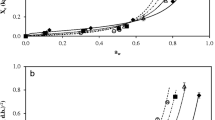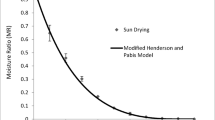Abstract
The aim of this work is to determine the desorption isotherms and the drying kinetics of bay laurel leaves (Laurus Nobilis L.). The desorption isotherms were performed at three temperature levels: 50, 60 and 70 °C and at water activity ranging from 0.057 to 0.88 using the statistic gravimetric method. Five sorption models were used to fit desorption experimental isotherm data. It was found that Kuhn model offers the best fitting of experimental moisture isotherms in the mentioned investigated ranges of temperature and water activity. The Net isosteric heat of water desorption was evaluated using The Clausius–Clapeyron equation and was then best correlated to equilibrium moisture content by the empirical Tsami’s equation. Thin layer convective drying curves of bay laurel leaves were obtained for temperatures of 45, 50, 60 and 70 °C, relative humidity of 5, 15, 30 and 45 % and air velocities of 1, 1.5 and 2 m/s. A non linear regression procedure of Levenberg–Marquardt was used to fit drying curves with five semi empirical mathematical models available in the literature, The R2 and χ2 were used to evaluate the goodness of fit of models to data. Based on the experimental drying curves the drying characteristic curve (DCC) has been established and fitted with a third degree polynomial function. It was found that the Midilli Kucuk model was the best semi-empirical model describing thin layer drying kinetics of bay laurel leaves. The bay laurel leaves effective moisture diffusivity and activation energy were also identified.









Similar content being viewed by others

Abbreviations
- aw:
-
Water activity
- Va:
-
Air velocity (m/s)
- T:
-
Temperature (°K)
- HR:
-
Air relative humidity (%)
- me :
-
Water mass in the product (Kg)
- ms :
-
Dry matter mass (Kg)
- X:
-
Product moisture content at dry basis (Kg water/Kg dry matter)
- X0 :
-
Initial moisture content (Kg water/Kg dry matter)
- Xt :
-
Average moisture content at time t (Kg water/Kg dry matter)
- Xe :
-
Equilibrium moisture content (Kg water/Kg dry matter)
- XR:
-
Moisture ratio
- XRi,exp :
-
ith experimental moisture ratio
- XRi,pre :
-
ith predicted moisture ratio
- \(\overline{\text{XR}}\) :
-
Average value of experimental moisture ratio
- N:
-
Number of observations
- Z:
-
Number of constants in the drying model
- Qst,n :
-
Net isosteric heat of desorption (kJ/mol)
- R:
-
Ideal gaz constant (J/mol/K)
- P:
-
Slope of the desorption isosters
- F (φ):
-
Dimensionless draying rate
- t:
-
Time (s)
- r:
-
Space coordinate (m)
- Deff :
-
Effective moisture diffusivity (m2/s)
- D0 :
-
Pre-exponential factor of Arrhenius equation (m2/s)
- L:
-
Thickness of sample (m)
- Ea:
-
Activation energy (kJ/mol)
- a, b, c, k, k0, k1 :
-
Models constants
References
Skrubis BG (1982) The drying of bay leaves. Perfum Flavor 7(5):37–40
Ceylan A, Ozay N (1990) A study on the ontogenetical quality of bay leaves. J Fac Ege Univ 27(3):71–77
Yagcioglu A, Degirmencioglu A, Cagatay F (1999) Drying characteristic of bay leaves under different drying conditions. In: Proceeding of the 7th international congress on agricultural mechanization and energy, pp 26–27
Demir V (2004) Mathematical modeling and the determination of some quality paramaters of air-dried bay leaves. Biosyst Eng 88(3):325–335
Sellami IH, Wannes WA, Bettaieb I, Berrima S, Chahed T, Marzouk B, Limam F (2011) Qualitative and quantitative changes in the essential oil of laurus nobilis as affected by different drying methods. Food Chem 126:691–697
Doymaz I (2012) Thin layer drying of bay laurel leaves (Laurus Nobilis, L.). J Food Process Preserv 38(1):449–456
Kenneth H (1990) Official methods of analysis. Association of Official Analytical Chemists, Arlington
Hassini L, Azzouz S, Peczalski R, Belghith A (2007) Estimate off potato convective moisture diffusivity from drying kinetics with correction for shrinkage. Newsp Food Eng 39:47–56
Togrul IT, Pehlivan D (2004) Modelling of thin layer drying kinetics of some fruits under open-air sun drying process. J Food Eng 65:413–425
Kuhn I (1964) A new theoretical analysis of adsorption phenomena, expression of the main regular types of adsorption isotherms by a single simple equation. J Colloid Sci 19:685–698
Halsey G (1948) Physical adsorption on non-uniform surfaces. J Chem Phys 16:931–937
Henderson SM (1952) A basic concept of equilibrium moisture. Trans Am Soc Agric Eng 33:29
Oswin CR (1946) The kinetics of package life III. Isotherm J Chem Ind 65:419–421
Smith SE (1947) The sorption of water vapor by high polymers. J Am Chem Soc 69:646
Rizvi SSH (1986) Thermodynamic properties of foods in dehydration. In: Rao MA, Rizvi SSH (eds) Engineering properties of foods. Marcel Dekker Inc, New York, p 223
Tsami E (1991) Net isosteric heat of sorption in dried fruits. J Food Eng 14:327–335
Van Meel DA (1958) Adiabatic convection batch drying with recirculation of air. Chem Eng Sci 9:36–44
Bruce DM (1985) Exposed-layer barley drying, three models fitted to new data up to 150C. J Agric Eng Res 32:337–347
Wang CY, Singh RP (1978) Use of variable equilibrium moisture content in modeling rice drying. Trans Am Soc Agric Eng 11:668–672
Midilli A, Kucuk H, Yapar ZA (2002) New model for single-layer drying. Dry Technol 20(7):1503–1513
Crank J (1975) The mathematics of diffusion. Clarendon Press, Oxford
Simal S, Femenia A, Llull P, Rosello C (2000) Dehydration of aloe vera: simulation of drying curves and evaluation of functional properties. J Food Eng 43:109–114
Ait Mohamed L, Kouhila M, Lahsasnia S, Jamalia A, Idlimama A, Rhazia M, Aghfira M, Mahrouzb M (2005) Equilibrium moisture content and heat of sorption of Gelidium sesquipedale. J Stored Prod Res 41:199–209
Chenarbon HA, Movahed Hasheminia SH (2012) Moisture sorption isotherms of Rosemary (Rosmarinus officinalis L.) flowers at three temperatures. Am Eurasian J Agric Environ Sci 12(9):1209–1214
Nourhène B, Mohammed K, Nabil K (2008) Experimental and mathematical investigations of convective solar drying of four varieties of olive leaves. Food Bioprod Process 86:176–184
Medeni M, Fahrettin G (1997) The fitting of various models to water sorption isotherms of pistachio nut paste. J Food Eng 33:227–237
Marcel E, Alexis K, Kapseu C (2010) Determination of the Gnetum africanum water sorption isotherms for use in the design of an adapted dryer. Int J Food Sci Technol 45:105–112
Kiranoudis CT, Maroulis ZB, Tsami E, Marinos-Kouris D (1993) Equilibrium moisture content and heat of desorption of some vegetables. J Food Eng 20:55–74
Bories S, Prat M, (1996) Transferts de chaleur dans les milieux poreux, Technique de l’ingénieur, traité génie énergétique, N 600682, ISTRA B1, France
Jannot Y (2008) Isothermes de sorption: modèles et détermination, cours. http://www.thermique55.com/principal/thermiquesolaire.pdf
Brunauer S (1938) Adsorption of gases in multimolecular layers. J Am Chem Soc 60:309–319
Langmuir I (1918) The adsorption of gases on plane surfaces of glass, mica and platinum. J Am Chem Soc 40:1361–1403
Iglesias HA (1978) Equations for fitting water sorption isotherms of foods. J Food Technol 13:159–174
Lopez A, Iguaz A, Esnoz A, Virseda P (2000) Thin-layer drying behaviour of vegetable waste from wholesale market. Dry Technol 18:995–1006
Benhamou A (2008) Diffusivité hydrique et cinétique de séchage solaire en convection forcée des feuilles de marjolaine. Revue des Energies Renouvelables 11(1):75–85
Author information
Authors and Affiliations
Corresponding author
Rights and permissions
About this article
Cite this article
Ghnimi, T., Hassini, L. & Bagane, M. Experimental study of water desorption isotherms and thin-layer convective drying kinetics of bay laurel leaves. Heat Mass Transfer 52, 2649–2659 (2016). https://doi.org/10.1007/s00231-016-1770-0
Received:
Accepted:
Published:
Issue Date:
DOI: https://doi.org/10.1007/s00231-016-1770-0



